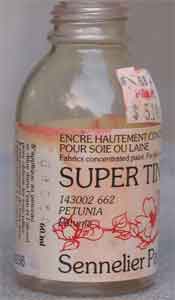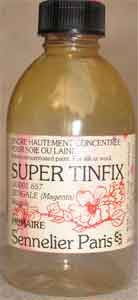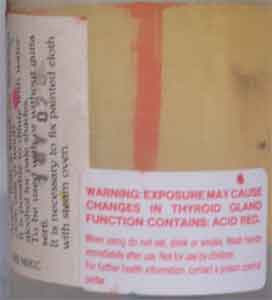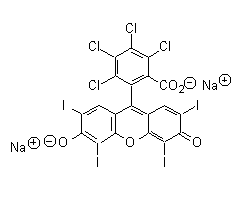Did Sennelier Tinfix Silk Dyes cause my wife's hyperthyroidism?


It is very interesting that your Super Tinfix dye bottles bear a warning about possibly causing thyroid disease. How very disappointing that the Sennelier company refused to provide further information! I wonder if they are refusing to release this information in an attempt to avoid legal repercussions.
One acid dye that contains iodine is erythrosine, a food dye. Eating this dye in foods can result in the release of the iodine it contains within the body, which in large doses can certainly affect the thyroid. Although it is very possible that consuming large amounts of this dye, which is known as FD&C Red No. 3 or Colour Index Acid Red 51, would have effects on the thyroid, it seems unlikely that a dye which is used for food would be very harmful in the much smaller quantities that one might absorb as the result of accidental exposure while painting with it. Presumably only small quantities would have been spilled on the hands, and much smaller quantities absorbed orally, as the result of putting the hands to the mouth, eating, smoking, or anything else like that, before washing one's hands. It appears that a daily intake of FD&C red #3 of 60 milligrams daily long-term is without any effects in humans.
However, there certainly could be another acid red dye, besides erythrosine, which has thyroid effects. Food colors must pass animal feeding tests, but the other dyes which are used in products such as Super Tinfx dyes do not; if there are other acid dyes which contain iodine, their effects could, in theory, be much more significant than those of FD&C red #3. Unfortunately, I have not been able to locate the names of such dyes for you. There are hundreds of acid dyes whose Colour Index names begin with "Acid Red". There should be a number following that part of the name, but Sennelier omitted it as a part of their program of secrecy concerning the contents of their dyes. I have never been able to find out the exact identity of any of the French silk dyes, though I have been trying for years.
Whether the dyes themselves led to your wife's disease is open to question. It is not impossible, but autoimmune thyroid disease is common in developed countries, so it will be hard to be sure where to affix blame.
I believe that the most common cause of autoimmune thyroid disease, including Grave's disease and Hashimoto's thyroiditis, is excessive dietary intake of iodine, which is very widespread. In many countries, serious developmental defects, including mental retardation, arise as the result of iodine deficiency; in order to prevent this, many countries such as the US have fortified salt with iodine. The benefit of preventing the devastating mental effects of iodine deficiency in children is well worth the increased incidence of thyroid disease in the adult population, but the large amounts of salt used in prepared foods and restaurant foods can cause an individual's intake of iodine to be much greater than intended. In addition, the use of iodine as a disinfectant contributes massively to iodine intake in North America. The amount of iodine found in milk and other dairy products, as the result of iodine use to disinfect cow's udders, is nothing short of astonishing, averaging 230 micrograms per quart of milk. This alone is sufficient to meet one's daily dietary needs, even in the absence of other iodine-containing foods, as the US RDA of iodine is only 150 micrograms per day. In spite of all of the above, however, most good multivitamin pills contain a full 150 micrograms of iodine per pill. A person who eats restaurant food or prepared food, drinks ordinary quantities of milk, and also takes a daily vitamin pill, will easily exceed the recommended intake of iodine several times over, day after day. Iodine is also used in large doses as a contrast agent for some medical imaging, but there is nothing that can be done about that.
Attached are some additional photos in case you would like to use them.


The
additional photos you sent gave me another clue as to the possible identity of
the thyroid-affecting dyes you had obtained from Sennelier. Here is another
iodine-containing dye: one of the photos you just sent was labeled with the
color 'Bengale', which reminded me of the Rose Bengal dye I used in my
dissertation work. Sure enough, Rose Bengal does contain
iodine:
Apparently
this dye has what is described as a 'weak goitrogenic effect'. It is also known
as "Acid Red 94". This is a strong candidate for being one of the dyes
included in the formulas of the old dyes whose bottles you found the warning
label on. The similarity in name is suggestive, though not proof of its
identity.
I recall that Rose Bengal was a lovely color. I was working
with bacteria, in my PhD work, so was unaware of thyroid issues at the time.
Rose Bengal has been used as a food coloring, somewhere, but it is not approved
for use as a food additive in the US. Unlike many of the dyes in my
research, Rose Bengal does not intercalate into DNA, and is therefore less
worrisome as a possible source of DNA damage.
(Please help support this web
site. Thank you.)
Posted: Thursday - August 30, 2007 at 08:31 AM
Follow this blog on twitter here.
- Top of this blog -
- FAQ -
- The Dye Forum -
- How to Tie Dye - How to Batik -
- Books - Toys - Plants -
More in this category:
- -
Total entries in this category:
Published On: Aug 29, 2012 02:47 PM